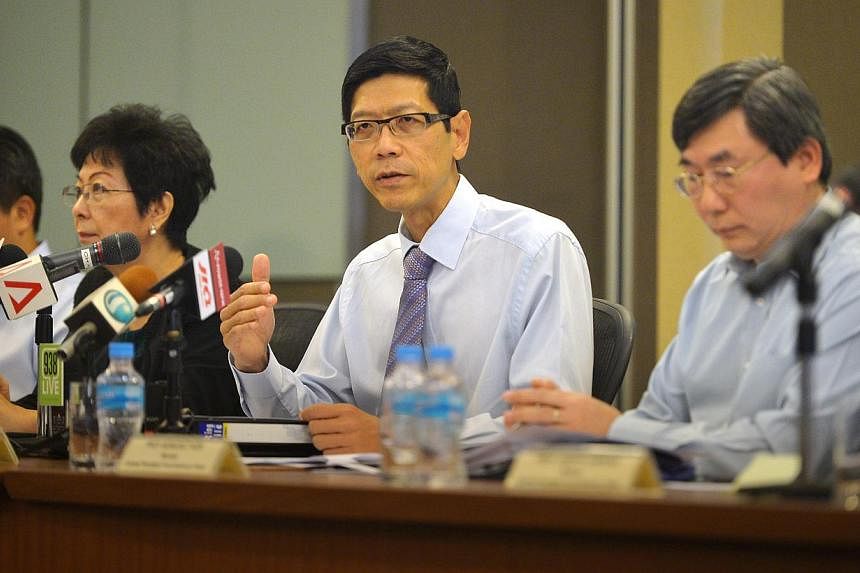SINGAPORE - Here are three examples to illustrate the Central Provident Fund (CPF) Advisory Panel's recommendations.
Example 1:
Mr Ang turns 55 in 2016 and has CPF savings of $20,000.
When he turns 55, $5,000 is set aside and can be withdrawn at any time. The rest ($15,000) would need to be set aside in the Retirement Account.
By the time Mr Ang reaches his Payout Eligibility Age (when he is 65), the sum of $15,000 in his Retirement Account would have grown to $24,000 because of the interest received from CPF.
When he is 65, he would not have the option to make a further 20 per cent withdrawal. This is because the $5,000 he could withdraw when he is 55 or after is more than 20 per cent of his Retirement Account savings when he is 65. This would ensure his monthly CPF payout is not reduced further as he has low CPF balances.
Mr Ang can opt to join CPF Life, which would provide monthly payouts of $140 for life. He would need to choose his payout start age, as well as a CPF Life plan.
If he decides not to join CPF Life, his CPF savings will be streamed out as monthly payouts until the sum is exhausted.
Example 2:
Mr Bakar turns 55 in 2016 and has CPF savings of $85,500.
When Mr Bakar is 55, $5,000 is set aside and can be withdrawn at any time, and the rest ($80,500) would need to be set aside in the Retirement Account.
By the time he reaches his Payout Eligibility Age (when he is 65), the sum of $80,500 in his Retirement Account would have grown to $123,600 because of the interest received from CPF.
When Mr Bakar turns 65, he would have to first decide whether or not to set aside for withdrawal 20 per cent of the $123,600, less the $5,000 he could already withdraw at any time after he turns 55, which amounts to $19,700. If he makes the withdrawal, however, it would lower the monthly payout that he would subsequently receive, from $680 to $580.
He would next have to choose his payout start age. He can opt to have monthly payouts start at 65 or later - at 66, 67 and up to age 70. For every year that his payout start age is deferred, monthly payouts permanently increase by 6 to 7 per cent. Before his payouts commence, he would choose his CPF Life plan.
Example 3:
Mr Chan turns 55 in 2016 and has CPF savings of $200,000.
When he turns 55, he can set aside the Full Retirement Sum of $161,000, which would provide him a monthly payout of about $1,300 a month, starting at age 65, for life. He can withdraw his CPF savings in excess of this sum - that is, $39,000.
If he has property, he can opt to set aside the Basic Retirement Sum of $80,500, subject to a charge or pledge on the value of the property. His Retirement Account savings above the Basic Retirement Sum of $80,500 can also then be withdrawn - that is, a total of $119,500 can be withdrawn at age 55. The payout he will receive from age 65 will vary according to the sum set aside.
Alternatively, he could opt to set aside an Enhanced Retirement Sum, which can vary from more than $161,000 to a maximum of $241,500 (that is, three times the Basic Retirement Sum), in order to receive a higher monthly payout. For example, if he chooses to top up to the maximum allowed, he could do this with his excess CPF savings of $39,000, and cash of $41,500.
Assuming he opts for the Full Retirement Sum of $161,000 when he turns 55, when he reaches 65, the sum he has set aside would have grown to $240,500 because of interest received from CPF.
At his Payout Eligibility Age of 65, he would have to first decide whether or not to set aside a sum for withdrawal - 20 per cent of $240,500, less $5,000, which amounts to $43,100. If he makes this withdrawal, however, it would lower the monthly payout he would subsequently receive - from $1,300 a month to $1,060 a month.
Next, he would need to choose his payout start age. He can opt for monthly payouts starting from age 65 or later, up to age 70. For every year that his payout start age is deferred, monthly payouts permanently increase by 6 to 7 per cent. Before his payouts commence, he would choose his CPF Life plan.


